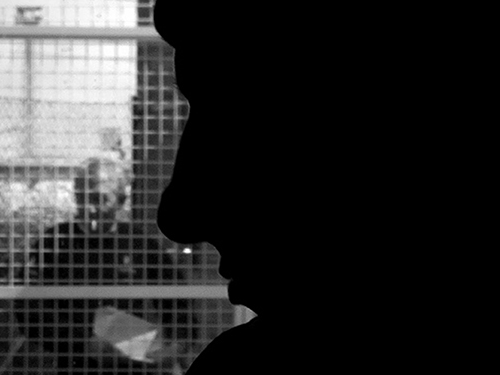
Not Waving, But Drowning materialises the experience of Indian refugees during their arrest and detention by the harbour police in Zeebruges, Belgium. Within the tense, haunted context of the harbour and the seaside, and together with them, we slowly lose all sense of time and place. Without investigating their past or their future, the human traffic organisations or the Belgian legislation, the film transgresses into the timelessness in which our society imprisons people without papers. This analysis of human exclusion and the reduction of human beings to the physical body makes us wonder if a human can be illegal at all?1
“Not Waving, But Drowning is set in a detention centre in the Belgian harbour town of Zeebrugge and documents the waiting time of a group of young Indian migrants who were arrested here on their way to the UK. Left without a translator, they remain uninformed about the nature and length of their detainment. Their bodies are disassociated from all productive activity in this confined space. Their existence revolves solely around fighting boredom and killing time, they are reduced to an immediate immersion in the present moment. They are drowning in a sea of time. There is nothing to do for them but to lie around: to sleep, to eat, to compulsively wash hands, to stare out of the window, to sing mournful songs. […] In order to explore how this temporal regime manifests itself in the migrants’ minds and bodies, Grootaers frequently takes on the detainees’ perspective. His camera stands on their side, follows their views through the glass door to the exterior corridor, and shows us what they can see. Thus, the policemen appear as intruders in the migrants’ space and we feel their disconcertment about the incomprehensible explanations and orders they receive. The images he composes feel constricted and often are framed by doors or barred windows. The sound attains a haptic quality, with the locking and opening of doors producing a visceral feeling on the side of the audience.”
Steffen Köhn2
“Alternating between exposure and occlusion, the film’s impressionistic aesthetic style acts in contention with its documentary aspirations to draw audiences’ attention to the realities of forced migration and Europe’s response to the presence of asylum seekers on its borders. Only ever depicting his subjects partially, Grootaers shoots either in extreme close up – an eye, a hand – or through some visual obstacle such as a steamy window or metal grill. While documenting their physical incarceration, these claustrophobic shots also refuse to present the asylum seekers as whole and knowable beings, disrupting the more traditional generic aims of documentary: to bring something to light and expose it to scrutiny. Questioning the ethics of his own act of representation in this way, Grootaers shields the asylum seekers he depicts from the ambiguous gaze of the camera, demonstrating his awareness of the vulnerability of the film’s subjects and the dangers inherent in their exposure. […] Perhaps the prevailing insight afforded by Grootaers’s image, and the film as a whole, is that representations cloud as much as they clarify, and that this tension between occlusion and revelation is most ethically and politically pressing in relation to disenfranchised groups who have only limited access to the means of self-representation.”
Agnes Woolley3
“Net door deze kunst van het uitwissen komen we uiteindelijk oog in oog met de Homo Sacer te staan: een spook, verlaten en onvrij. De Indiase vluchtelingen zitten verstopt achter een masker van montage dat de nadruk legt op een verbod dat van buitenaf komt: traliewerk, afgeschermde plekken, beperkte zichtbaarheid. Er rest de vluchtelingen blijkbaar alleen nog een zee van tijd. Om te slapen, te piekeren of klaagzangen te zingen, herhaaldelijk de handen te wassen en op een landkaart te staren naar plaatsen waar ze willen zijn. Not Waving, But Drowning toont zich zo ook als een reisverhaal, maar dan met de nadruk op de abrupte stilstand ervan. […] Enerzijds wordt het zelfbedrog van de orthodoxe documentairemaker ontmaskerd: het is niet omdat een delicaat onderwerp zijn schoonheid wordt ontzegd, dat een film geëngageerd, respectvol en dus ethisch verantwoord is. We weten intussen allemaal dat waarachtigheid niet van een stijl afhankelijk is. Hoewel we ons nu des te meer kunnen afvragen of de stijlloze stijl van de direct cinema geen cliché is geworden die de confrontatie met een kwetsbaar onderwerp binnen een stereotiep journalistiek format kanaliseert en daardoor ook systematisch ontwijkt. Anderzijds toont Grootaers dat de spanning tussen ethiek en esthetiek een toegang biedt tot de hedendaagse, geconditioneerde kijker. De schoonheid heeft hier immers iets ongemakkelijks.”
Robrecht Vanderbeeken4
- 1From Elias Grootaers’ website.
- 2Steffen Köhn, Mediating Mobility (London and New York: Wallflower Press, 2016).
- 3Agnes Woolley, Contemporary Asylum Narratives. Representing Refugees in the Twenty-First Century (London: Palgrave Macmillan, 2014).
- 4“Vluchtelingen in documentaire film. De schoonheid van een aangespoelde man”.

